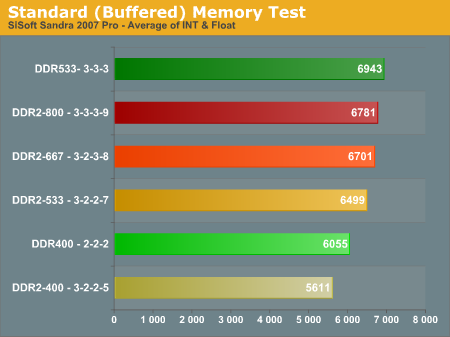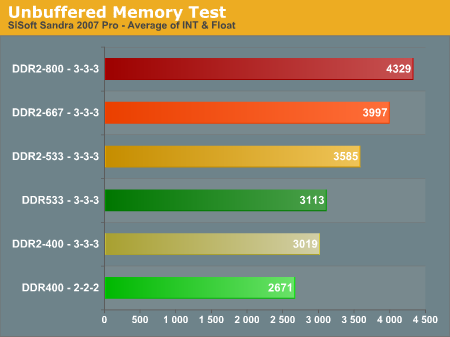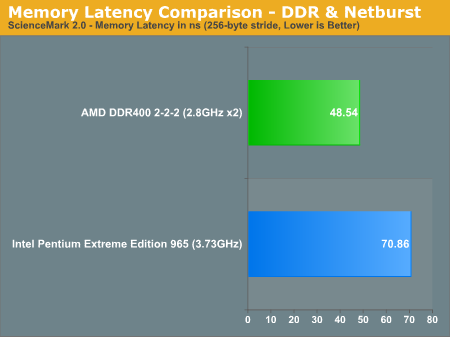DDR/NetBurst Memory Bandwidth and Latency
One of the most talked-about AMD advantages of the last couple of years has been their on-processor memory controller. This has allowed, according to popular theories, the Athlon64 to significantly outperform Intel NetBurst processors. The fact is NetBurst DDR2 bandwidth has recently been similar or wider in bandwidth than Athlon64 - even when the DDR is overclocked. You can see this clearly when we compare Buffered and Unbuffered Bandwidth of a NetBurst 3.46EE to an AMD 4800+ x2(2.4GHz, 2x1MB Cache) running DDR400 2-2-2 and running overclocked memory at DDR533 3-3-3.
The green bars represent DDR memory performance, while the beige to red are increasing DDR2 speed on NetBurst. Light green represents DDR400 2-2-2 while Dark Green is overclocked memory at the same CPU speed, DDR533 at 3-3-3.

In buffered performance, Fast DDR400 is only faster than DDR2-400 and slower than DDR2-533, 667 and 800. Overclocked memory at DDR533 3-3-3 is faster than any of the DDR2 bandwidths on NetBurst.
The Sandra Unbuffered Memory Test, which turns off features that tend to artificially boost performance, is generally a better measure of how memory will behave comparatively in gaming. The same green for DDR applies here.

Without Buffering, DDR400 has the smallest bandwidth of tested memory speeds and timings. Even overclocking to DDR533 allows the DDR to barely beat DDR2-400. DDR2-533, 667, and 800 all have greater Unbuffered bandwidth than the DDR overclocked to 533. NetBurst DDR2 memory bandwidth is generally wider than the bandwidth supplied by DDR memory on Athlon64. Despite the wider bandwidth, the deep pipelines and other inefficiencies in the NetBurst design did not allow the NetBurst processors to outperform Athlon64. Keep this in mind later, when we look at AM2 and Core 2 Duo Memory Bandwidth.
Latency
The other area where AMD has had an advantage over NetBurst DDR2 performance is memory latency, the result of the on-processor memory controller. Comparison of the AMD DDR Memory controller and the Intel DDR2 Memory controller in the Intel chipset shows AMD DDR with latency about 35% lower than Intel NetBurst in Science Mark 2.0.

While memory bandwidth was very similar between AMD and NetBurst, the deep pipes of the NetBurst design still behaved as if they were bandwidth starved. On the other hand the AMD architecture made use of the bandwidth available and the much lower latency to outperform NetBurst across the board.
One of the most talked-about AMD advantages of the last couple of years has been their on-processor memory controller. This has allowed, according to popular theories, the Athlon64 to significantly outperform Intel NetBurst processors. The fact is NetBurst DDR2 bandwidth has recently been similar or wider in bandwidth than Athlon64 - even when the DDR is overclocked. You can see this clearly when we compare Buffered and Unbuffered Bandwidth of a NetBurst 3.46EE to an AMD 4800+ x2(2.4GHz, 2x1MB Cache) running DDR400 2-2-2 and running overclocked memory at DDR533 3-3-3.
The green bars represent DDR memory performance, while the beige to red are increasing DDR2 speed on NetBurst. Light green represents DDR400 2-2-2 while Dark Green is overclocked memory at the same CPU speed, DDR533 at 3-3-3.

In buffered performance, Fast DDR400 is only faster than DDR2-400 and slower than DDR2-533, 667 and 800. Overclocked memory at DDR533 3-3-3 is faster than any of the DDR2 bandwidths on NetBurst.
The Sandra Unbuffered Memory Test, which turns off features that tend to artificially boost performance, is generally a better measure of how memory will behave comparatively in gaming. The same green for DDR applies here.

Without Buffering, DDR400 has the smallest bandwidth of tested memory speeds and timings. Even overclocking to DDR533 allows the DDR to barely beat DDR2-400. DDR2-533, 667, and 800 all have greater Unbuffered bandwidth than the DDR overclocked to 533. NetBurst DDR2 memory bandwidth is generally wider than the bandwidth supplied by DDR memory on Athlon64. Despite the wider bandwidth, the deep pipelines and other inefficiencies in the NetBurst design did not allow the NetBurst processors to outperform Athlon64. Keep this in mind later, when we look at AM2 and Core 2 Duo Memory Bandwidth.
Latency
The other area where AMD has had an advantage over NetBurst DDR2 performance is memory latency, the result of the on-processor memory controller. Comparison of the AMD DDR Memory controller and the Intel DDR2 Memory controller in the Intel chipset shows AMD DDR with latency about 35% lower than Intel NetBurst in Science Mark 2.0.

While memory bandwidth was very similar between AMD and NetBurst, the deep pipes of the NetBurst design still behaved as if they were bandwidth starved. On the other hand the AMD architecture made use of the bandwidth available and the much lower latency to outperform NetBurst across the board.










118 Comments
View All Comments
Coogcheese - Tuesday, July 25, 2006 - link
Is the latency issue really due to intelligent look-ahead or the vast cache size difference between the two processors? I'd like to see a benchmark comparison between an 2MB cache opeteron and an equally cached/clocked/timed Conroe. That would settle some debate (yea, yea...wishful thinking).It could also help lend some insite to what AMD might do in the short & long term as a response as well.
The author of the review seems to give alot of credit to "look-ahead" but I found this benchmark comparison to be interesting: http://www.hexus.net/content/item.php?item=6256&am...">http://www.hexus.net/content/item.php?item=6256&am...
Opteron doesn't seem to have same problem that the Athlon does in terms of latency performance. Which could be why amd execs seem less than panicky at this point. It would allude to a market war similar to the megahurtz war that led to amd coming out with the model # system...this time it could be intel taking advantage of their capacity by laying the cache size smack down on amd instead of megahurtz.
If it is cache size and not "look-ahead" then amd could (could mind you...but would they? and how many could they?) respond much quicker I'd think. If its new technology or a combo of cache and new tech then amd will be in a much worse position imho.
Whatever the case its great for the consumer(me). Thank goodness for competition. Daddy needs a new pair of cores...and the price just got a whole lot better!
ChronoReverse - Tuesday, July 25, 2006 - link
It would indeed be very interesting to see a 2MB L2 1.6GHz Core 2 Duo E6200 compared against 2MB L2 1.6GHz Opteron 160.The shared L2 cache of the Conroe will give it a nice advantage though.
bob661 - Tuesday, July 25, 2006 - link
Anyonehave any speculation as to how much the initial Conroe's will cost? We pretty much know that the motherboards will be expensive but what about the CPU's?ChronoReverse - Tuesday, July 25, 2006 - link
The pricing has been out for a while already. They're relatively reasonable considering the performance. Only the Extreme Edition as usual is really expensive (but still not as expensive as I'd have thought).Too bad the motherboards are so expensive. I'm taking a look at that Asrock board, but I doubt it'll have any good overclocking capability.
Gary Key - Tuesday, July 25, 2006 - link
The less expensive boards for Conroe will fully hit the market near the end of August. ;-) We expect to see ECS, Foxconn, MSI, Epox, and others fully ramped up in a couple of weeks on the value boards. Until then, the Gigabyte DS3 is a really good board for overclocking the E6300/E6400 series and our Biostar and Abit boards continue to improve with each bios release. All three are under $145 now with others joining them shortly if the P965 is interesting to you. The ASRock board actually surprised us, but remember the VCore voltage cannot be adjusted. The $50~$100 market will be very interesting as the 945P, 946PL, and NV570SLI chipsets will dominate this section until the G965 boards start arriving in September if decent intergrated graphics are on your wish list, if not all of the boards will offer good performance for the money. The under $55 market will consist of VIA and SIS chipsets from PC-Chips and ASRock with a few majors like ECS and MSI having boards based on these chipsets.
Wesley Fink - Tuesday, July 25, 2006 - link
Everest Scores have been rerun with Version 3.01, which was released on July 16, 2006. Since the scores from the new version can not be compared to older Everest scores, we reran all the Everest benchmarks. 3.01 is said to provide full and complete support for Conroe and Merom. Values are different in that Memory WRITE and READ scores are reported as much higher than past Everest testing. Latency is also reported as closer between AM2 and Core 2 Duo with the 3.01 version of Everest. Charts and commentary have been revised using the new results.jjunos - Tuesday, July 25, 2006 - link
Thanks for the update wes! It always shows the quality of the website when they listen to their community and and willing to rerun all their tests in the sake of being correct! kudos!TonyB - Tuesday, July 25, 2006 - link
is it just me or did AMD just get pwned?bob661 - Tuesday, July 25, 2006 - link
I personally don't care about who owns who. I just want competition so I can get this stuff for cheap. I'm a best bang for the buck guy.goinginstyle - Tuesday, July 25, 2006 - link
Everyone benefits here with the performance improvements Intel has brought to the table and an AM2 3800+ at $150 is just an incredible value. Conroe made it easy for AMD users to upgrade their performance for very little money.